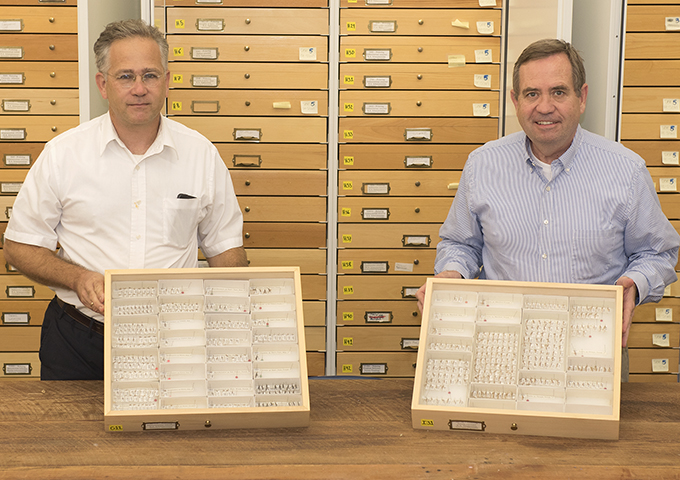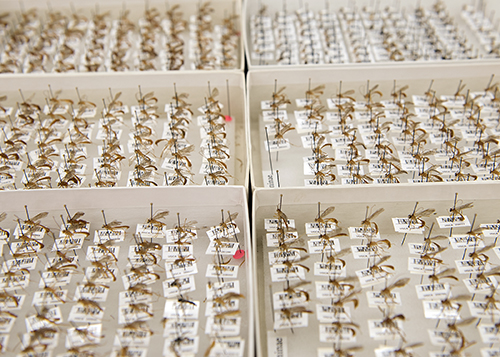Today@Sam Article
Natural History Museum Gets Buzz-Worthy Donation
Nov. 29, 2016
SHSU Media Contact: Tyler Pointer
 |
| SHSU Natural History Museum Curator William Godwin and associate vice-president for the Office of Research and Sponsored Programs Jerry Cook show off some of the 300,000 parasitic wasps recently donated to the museum by collector and Discover Life curator John Pickering, who will move the program to SHSU next semester. —Photos by Brian Blalock |
The Museum of Natural History at Sam Houston State University is now home to more than 300,000 parasitic wasp specimens that can be used for research and various biological functions.
According to Jerry Cook, professor of biology and associate vice-president for the Office of Research and Sponsored Programs, the wasps are a part of the Discover Life program and database that is making its move to SHSU next semester.
John Pickering, who curates Discover Life, donated the wasp collection to the Natural History Museum. Pickering will work to transition his collections and research to a new home there.
A significant part of Pickering’s scientific research is in the collection of parasitic wasps that he accumulated mostly from Central America as far back as the 1970s, according to Cook.
Since these wasps are parasitic, they must find hosts like caterpillars in the habitat they reside in to survive, according to Cook.
“The living forms of the parasitic wasps are very important for controlling populations, both pest and natural,” Cook said. “If some of the natural populations of these moths’ and butterflies’ caterpillars did not have these natural enemies, their populations would just explode.”
According to Cook, researching these wasps can provide experts with knowledge on their biological functions and how environments across the world can benefit from the introduction of the specimens.
 “When they’re dead like this, it’s important for the taxonomy and identification of the group,” Cook said. “There’s also new techniques using DNA methods and you can look at population structures and ecological factors. So museum specimens are being used more and more for studies and ecology now.”
“When they’re dead like this, it’s important for the taxonomy and identification of the group,” Cook said. “There’s also new techniques using DNA methods and you can look at population structures and ecological factors. So museum specimens are being used more and more for studies and ecology now.”
Introducing the wasps to areas that they do not originate from can control populations of pest and natural insects in an environmentally safe way, according to Cook.
“The method of introduction does not use insecticides or anything like that,” Cook said. “If it’s successful and you apply these wasps and bio-control, they just continue to control the population; you don’t have to reintroduce them.”
According to the Natural History Museum Curator William Godwin, the collection, which is the third largest in the nation, can give SHSU students the chance to directly work with some of the leading scientists in the field who come to SHSU to research the many species of wasps that are present.
“Our job is to build the education of the students at Sam Houston, and with a giant collection like that, we can attract the attention and time of the leading scientists of the world in that group,” Godwin said. “When the scientists come here to work on that, we make sure our students are working with them. It can build student resumes, experience and contacts.”
The collection itself is rare not only because of its contents, but the process of collecting and pinning these specimens is very costly and time-consuming, according to Cook.
“It’s a long process to pin them individually and pins can become expensive especially when there are 300,000 of them,” Cook said.
Godwin, who travelled 15 hours by van to personally bring the collection to the Natural History Museum, hopes that with the addition of the new specimens, more people can realize the importance of pinned specimens.
“People look at a museum and they think it’s just a collection, like a stamp collection, and it’s not,” Godwin said. “There’s a lot of use for those specimens that are still there. When we pin these bugs, we prepare them to last 300 to 400 years.”
- END -
This page maintained by SHSU's Communications Office:
Director of Content Communications: Emily Binetti
Asst. Director Content & Social Media: Emilee White
Communications Manager: Mikah Boyd
Telephone: 936.294.1837
Communications Specialist: Campbell Atkins
Telephone: 936.294.2638
